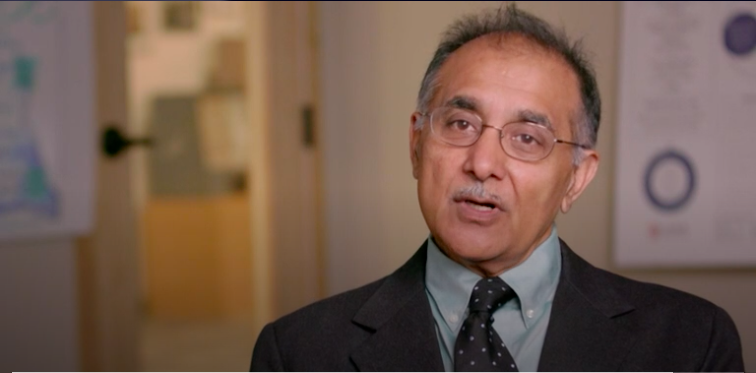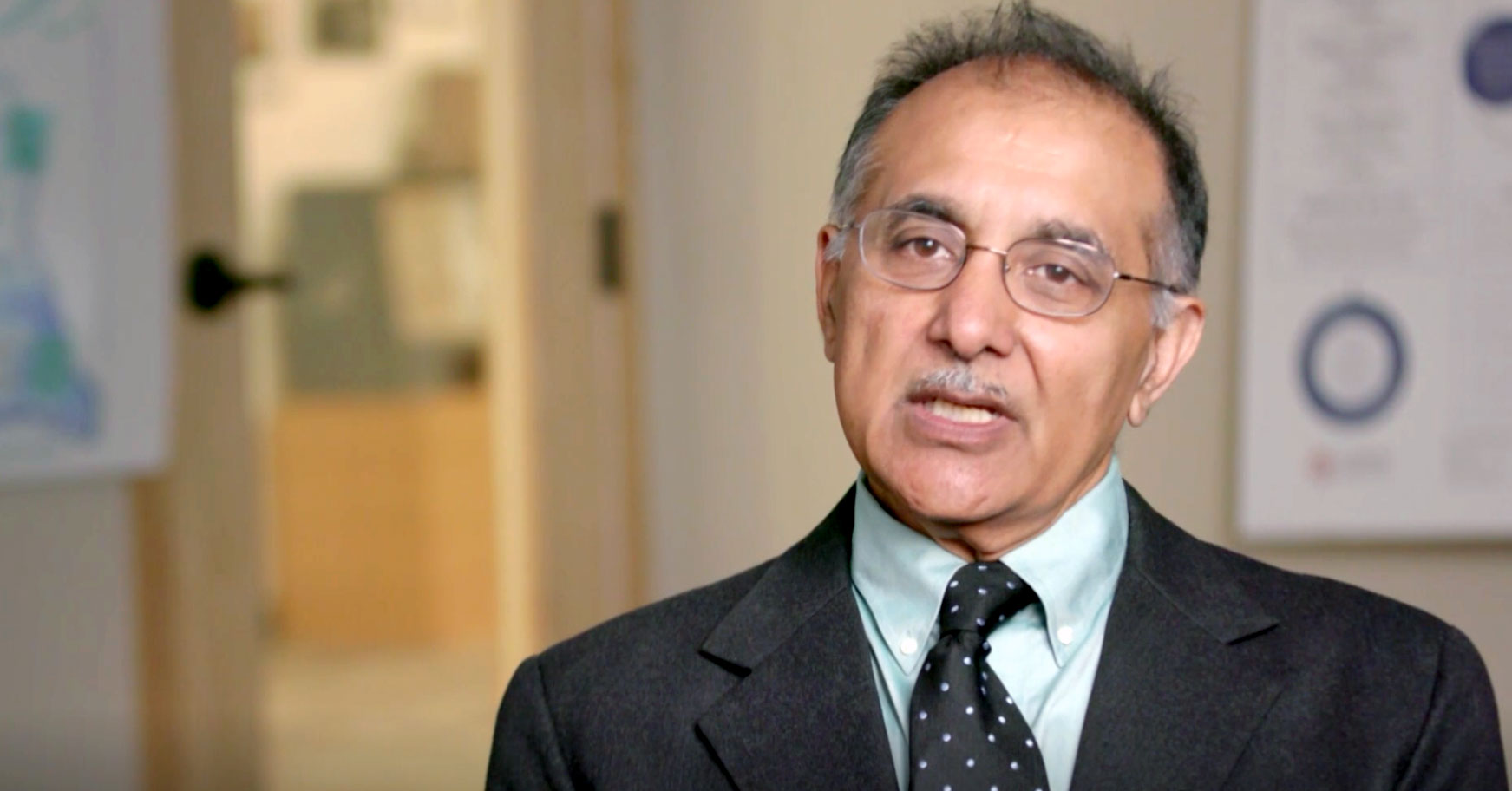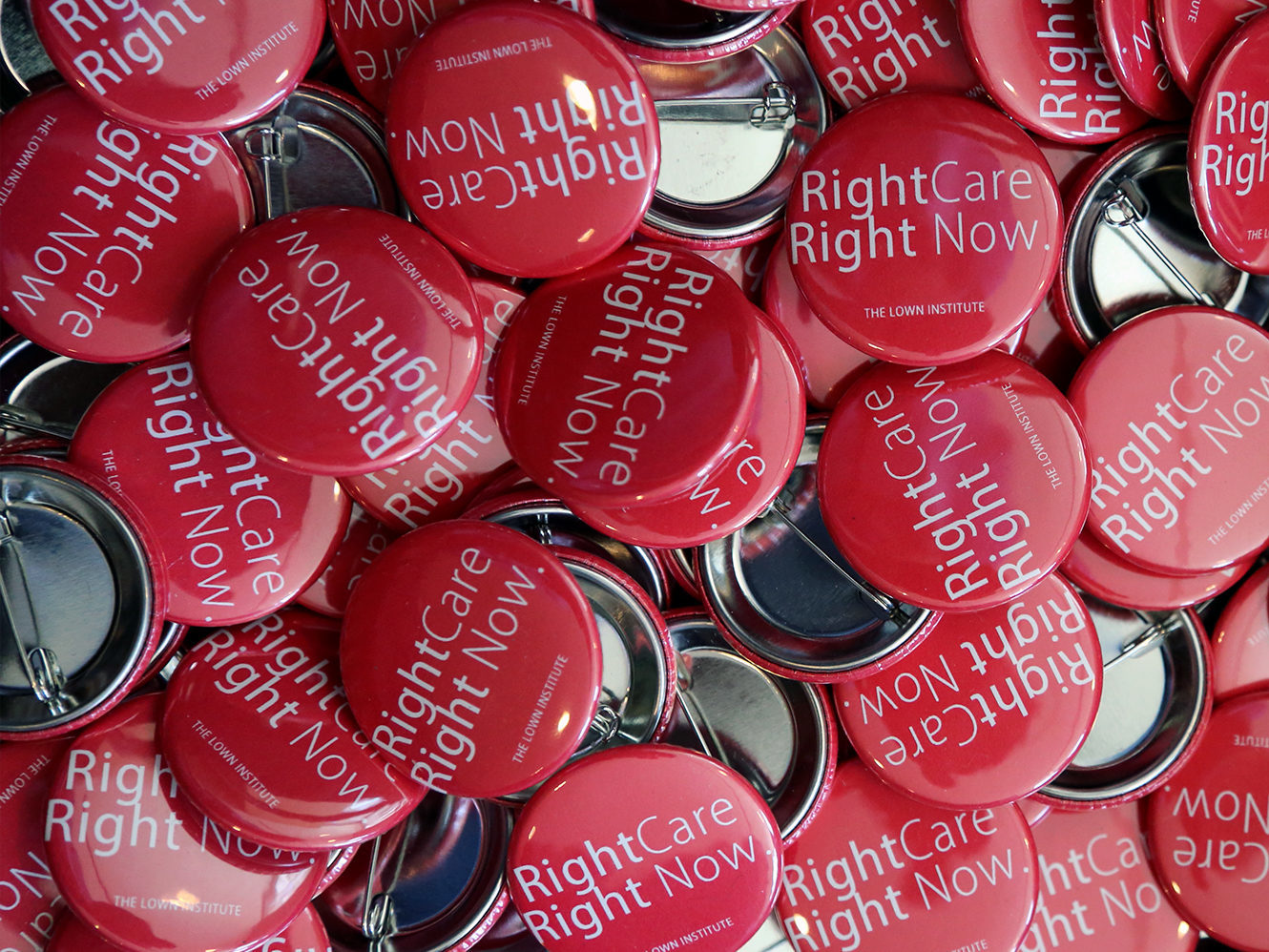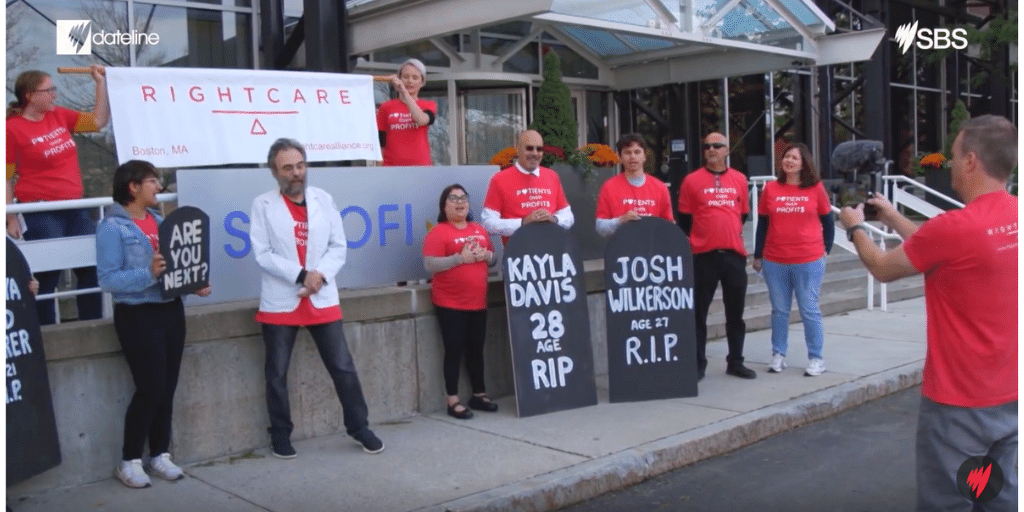
RCA co-chair responds to new Eli Lilly insulin co-pay limit
While this policy will help more people access insulin, it is “too little too late” from Lilly, said RCA co-chair Dr. Vikas Saini.
learn moreNo one with diabetes should die because they can’t afford their insulin. It’s a medicine that can be produced for just a few dollars… but manufacturers Eli Lilly, Sanofi, and Novo Nordisk mark up the price as much as 5,000 percent and there are seven million Americans with diabetes that have no choice but to pay.
The price is so high that people are doing desperate things to get by, like using expired insulin, relying on crowdfunding to pay their bills, or taking less insulin than they need in an effort to ration their supplies. Rationing is extremely dangerous and can lead to a deadly condition known as diabetic ketoacidosis. Four people died in 2017 while rationing their insulin. Four more died in 2018. Five died in 2019.

Blood-Money Protest at Eli Lilly, November 2019 — The Right Care Alliance organized and led this delivery of blood money to the Eli Lilly Innovation Center in Cambridge, MA on November 16, 2019. Parents and family of the deceased participated in pouring out blood in honor of their loved ones. Boston physicians declared an insulin crisis. Massachusetts citizens with diabetes shared how they are suffering and scared.
Gravestone delivery to Sanofi, March 2019 — A small group of patients, clinicians, activists, and people with with type 1 diabetes gathered at Sanofi pharmaceuticals to hold insulin manufacturers accountable for recent insulin rationing deaths. Activists brought wooden gravestones with the names and ages of six adults who died from insulin rationing. These gravestones became the backdrop for Right Care Alliance members with type 1 diabetes to tell their personal stories while honoring those who died because they could not afford the insulin they needed.
Ashes of the dead delivery to Sanofi, November 2018 — On November 16, 85+ patients, clinicians, students, and activists came to support the fight for lower insulin prices, along with more than five media crews to document the action. We marched and chanted to Sanofi headquarters, with the help of an activist marching band. Nicole Smith-Holt, James Holt Jr., and Antroinette Worsham, whose children died while rationing insulin, were at the head of the rally, hoping to send a message to the leadership of the Sanofi drug corporation by delivering the ashes of their loved ones.
Mother’s Day protest, May 2018 — For Mother’s Day 2018, we held rallies in Cambridge, Minneapolis, and Cincinatti with a total of more than 100 patients, clinicians, and activists in attendance. We also created virtual Mother’s Day cards with statements from the mothers of young adults who died from insulin rationing, calling on drug companies to lower the price of insulin. The cards gathered over 4,000 signatures online! We then printed 5-foot-high versions of the cards and delivered them to Sanofi pharmaceticals.
Jeremy Crawford, age 39, Dallas, TX (August 25, 2019) — After losing his job and insurance, Jeremy was struggling to afford the insulin he needed to survive. He tried using Walmart insulin but it didn’t work well for him. As he got sicker, he resisted calling 911 to get the help he needed because he could not afford it. He died from diabetic ketoacidosis.
Jesimya David Scherer, age 21, Minnesota (June 28, 2019) — In addition to managing his diabetes since he was age ten, Jesi worked two jobs to support himself, and was working on becoming an electrician. This year, however, it proved to be not enough, and he began rationing insulin, unable to fill prescriptions until the next payday. He was hospitalized in April with diabetic ketoacidosis. In June, two days after he’d last seen his family, he called in sick to work. He was found dead the following day.
Jada Renee Louis, age 24, Virginia (June 22, 2019) — A type 1 diabetic since age 7, Jada Louis found herself faced with a terrible choice this year – pay her rent or pay the $300 cost of insulin. After rationing landed her in the hospital for a week in June, she returned home in apparent good spirits. But a week later, she was dead. Jada, a lifelong lover of the performing arts, had a job at a local movie theater, but it was not enough to allow her to consistently afford her medications.
Josh Wilkerson, age 27, Virginia (June 14, 2019) — Josh and his fiancee, Rose Walters, both had type 1 diabetes. Josh managed a dog kennel, but was uninsured, and to help save for their wedding and new home, they decided to try using ReliOn, an older insulin they could purchase cheaply at Walmart. For Joshua, the insulin proved incompatible with his diabetes. During an overnight shift at the kennel, his blood sugar skyrocketed and he slipped into a coma, dying several days later.
Kayla Davis, age 28, Kentucky (June 5, 2019) — Kayla submitted a prescription for insulin to her pharmacy, but it could not be filled until her doctor’s office submitted the forms necessary to get it covered by Medicaid. She rationed the insulin she had left as she waited. Over the next week, she got sicker and sicker until she died from diabetic ketoacidosis. The approval for her insulin came though the next day.
Stephen “Stevie” Zachary Alford, age 22, Florida (April 26, 2019) — He was 22 years young. He did not live at home so his mother was unaware that he did not have all of his insulin. Because he was raised to be independent and self-sufficient, he took himself to the hospital. They treated him for 6 1/2 hours, wrote him a script for his insulin, and sent him on his way. 36 hours later he had a cardiac arrest and after an hour trying to save him, they pronounced him.
Meaghan Carter, age 47, Ohio (December 25, 2018) — Meaghan Carter had type 1 diabetes for 18 years. When she lost her job and insurance, she struggled to afford her insulin which cost more than $800 a month. She resorted to buying NPH insulin (intermediate-acting insulin) from Walmart, which is cheaper but much more unpredictable than the insulin she normally used. On Christmas Day, 2018, Meaghan died of diabetic ketoacidosis, one day before she would have received a paycheck that could have saved her life.
Micah Fischer, age 26, Wisconsin (November 4, 2018) — Micah aged off his father’s insurance plan in June of 2018. His new insurance did not cover Humalog, the insulin that worked best for him and was recommended by his doctor. It would cost $1,200 out-of-pocket. Micah rationed his insulin and go without eating so that less insulin was needed. He was excited to start a new job in October with an insurance plan that covered the insulin he needed, but the plan had a one month waiting period. He only had two and a half weeks to go until his new insurance kicked in when he died.
Allen Rivas, age 20, Texas (May 11, 2018) — Allen received Supplemental Security Income (SSI) as a youth, but was denied this benefit once he became an adult. His brittle diabetes made it difficult for him to hold a job and his mother could no longer afford to keep him on her insurance. He rationed his insulin and and then turned to Walmart insulin when he couldn’t afford more. He died in front of his mother–two days before Mother’s Day.
Jesse Lutgen, age 32, Iowa (February 7, 2018) — Jesse was diagnosed with type 1 diabetes when he was 12. Jesse had no problems with his diabetes as a child, but as an adult, the high cost of insulin and supplies became his largest financial problem. When Jesse lost his job in November 2017, it became even harder to manage his diabetes. He had made too much money that year to qualify for Medicaid, and the cheapest insurance available had a $10,000 deductible. He decided to pay out of pocket for insulin, but resorted to rationing because the out-of-pocket cost was so high.
Alec Raeshawn Smith, age 26, Minnesota (June 27, 2017) — Alec Smith was diagnosed with type 1 diabetes at age 23. When he turned 26 he was no longer able to be covered under his parents’ health insurance. Alec made too much money to qualify for Medicaid, but his job did not provide insurance. The cheapest insurance plan had a $7,500 deductible, so he decided to go uninsured. He was paying $1,300 a month for insulin and supplies, almost half of his salary. He died on June 27, 2017 from diabetic ketoacidosis, less than one month after going off of his mother’s insurance.
Antavia Lee Worsham, age 22, Ohio (April 26, 2017) — Antavia struggled to afford insulin when she turned 18 and was no longer eligible for insurance coverage through the state. She had resorted to borrowing insulin from others, changing her diet, and rationing insulin because she couldn’t afford it. Her insulin and supplies cost $1,000 a month. Her brother found her dead from diabetic ketoacidosis on April 26, 2017.
Shane Patrick Boyle, age 48, Arkansas (March 18, 2017) — As a comic book writer, Shane had struggled to afford insulin, but received help from friends and his community in Houston. When he went to visit his dying mother in Arkansas, he had no way of buying insulin. In February 2017, Shane Patrick Boyle started a GoFundMe campaign to raise money for a month of insulin. He was $50 short of the amount he needed and died from diabetic ketoacidosis on March 18, 2017, a few days after his mother died.
Monique Gabriel Moses, age 26 (2017) — Monique lost her job and her insurance. She could not afford her insulin and would ration what she had to make it last longer. Her mother talks about her in this news story.

While this policy will help more people access insulin, it is “too little too late” from Lilly, said RCA co-chair Dr. Vikas Saini.
learn more
Check out PBS’ new documentary Blood Sugar Rising: America’s Hidden Diabetes Epidemic, premiering Wed, April 15 at 9m EDT on your local PBS channel or online.
learn more
Join other RCA members for a virtual coffee hour to catch up and connect on Friday April 17, at 10am.
learn more
The Right Care Alliance is looking for a research intern for the summer. Learn more about the position and apply on Indeed.
learn more
Dateline Australia featured the Right Care Alliance and some of our friends in their recent expose on insulin and drug costs in the United States. Check this out to be heartbroken and inspired by the many ways that Americans are building … Read more
learn moreMOTHER’S DAY 2018 – Our five-foot tall Mother’s Day cards asked that no more sons or daughters die because they can’t afford their insulin. We got 5,000 people to sign them and made a delivery to the offices of an insulin manufacturer.
CBS Boston coverage of Sanofi protest featuring Nicole Smith-Holt and Antroinette Worsham
Right Care Boston leaders Vikas Saini and Chris Noble featured in FOX25 segment
STAT News coverage of Right Care Alliance members Antroinette Worsham and Myranda Pierce:
Bernie Sanders video featuring Right Care Alliance protest and Nicole Smith-Holt:
Dr. Vikas Saini on Yahoo Unfiltered: ‘There’s a sort of black market in insulin’:
Brittany Smith, Antroinette Worsham, and Dr. Vikas Saini on WGBH Greater Boston:
A MESSAGE from Dr. Vikas Saini, co-chair of the Right Care Alliance:
Our work is featured in the remarks of US REPRESENTATIVE JAN SCHAKOWSKY:
The Right Care Alliance is grateful for support from its funders, the RESIST Foundation and Ben and Jerry’s Foundation, which allow the Alliance to continue organizing for health care independently.
Our other partners in the fight for affordable insulin:
Contact us at organize@rightcarealliance.org.
Media inquiries should be directed to aaron@rightcarealliance.org.